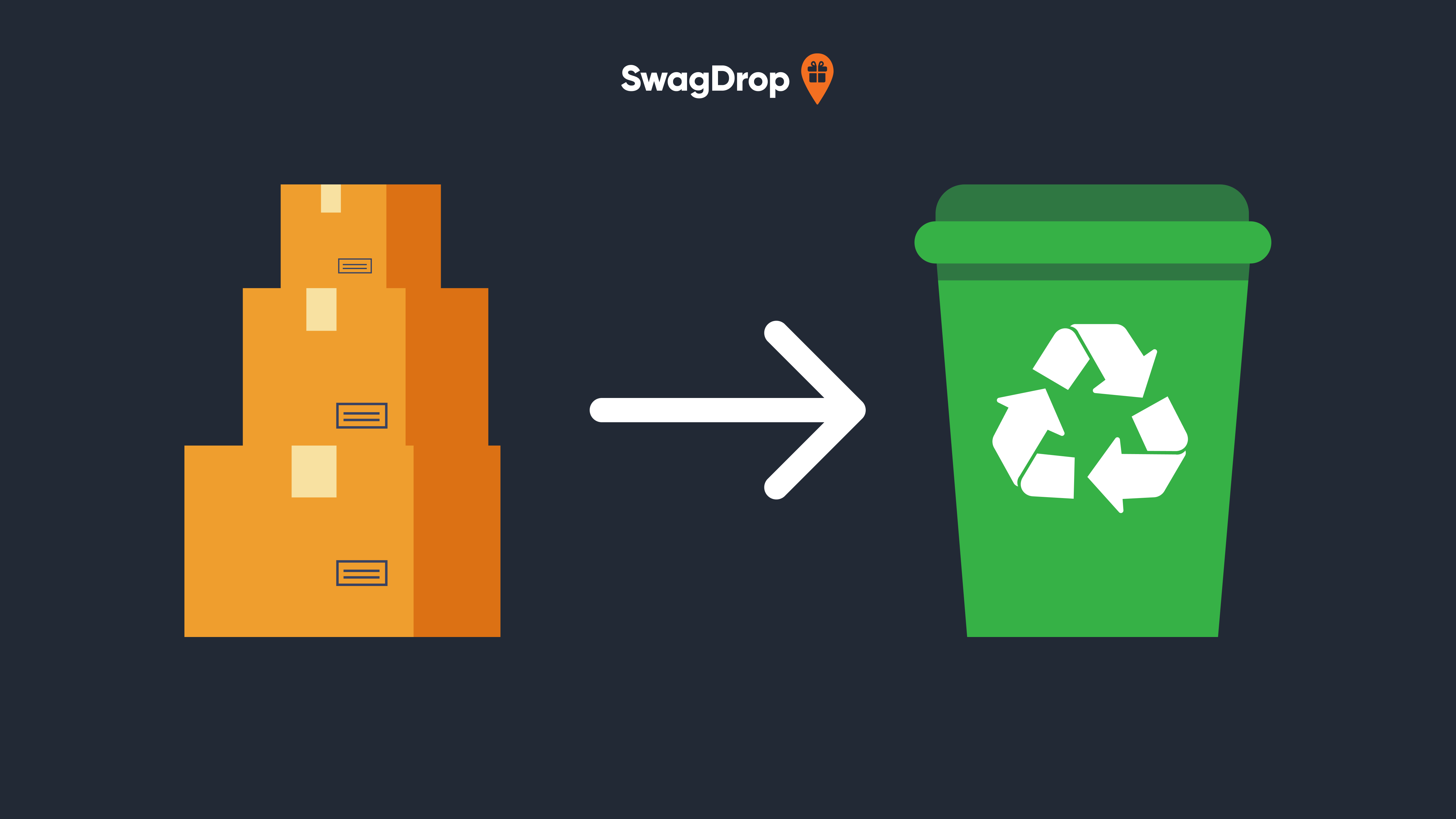Every marketing or HR leader knows that dreadful feeling: another quarter ends, and the branded hoodies, mugs, and tote bags are still sitting untouched in the warehouse.
All that swag you purchased in bulk to boost engagement quietly turns into environmental and financial waste.
It’s a familiar story that’s no longer sustainable.
At SwagDrop, we believe it’s time to rethink bulk swag programs and move toward on-demand, zero-waste corporate gifting.
Let’s start by analyzing why traditional programs fall short and exploring a smarter solution!

Table of Contents
The Problem With Bulk Swag Programs
Why Sustainability Messaging Alone Doesn’t Work
Frequently Asked Questions (FAQs)
The Problem With Bulk Swag Programs
Buying promotional products in bulk used to feel like a smart, safe move. You could stock up before giveaways, take advantage of volume discounts, and always have something ready for employees or clients.
But what looks smart on paper is quite different in reality. The actual costs of traditional bulk swag programs are higher than most companies realize.
Budget waste
Many companies spend thousands, or even millions, on bulk promotional gifts that employees and clients never use, then continue spending to store and manage them.
At SwagDrop, we’ve heard stories from marketing and HR teams navigating the fallout of bulk orders.
One team revealed they spent $150,000 on items no one wanted, ultimately disposing of them to prevent low-quality, outdated merchandise from circulating and harming their brand image.
Another company admitted to $50,000 in idle swag inventory, eventually giving it away at trade shows just to free up space.
The initial purchase price is only the beginning. Warehousing, insurance, handling, and inventory management costs can reach 25% of the total inventory value per year, according to Lokad.
You might get a stockpile of event swag at $10,000 with a volume discount, but after one year in storage, it will cost you $12,500.
Simply put, you keep investing in products you already own, draining your swag budget, instead of funding high-impact campaigns or employee experiences.
Learn how to stop paying rent for your swag in our latest article.
Dead inventory also creates administrative headaches, triggers internal finger-pointing across departments, and forces teams to make tough decisions about whether to donate, recycle, or dispose of obsolete merchandise.
Environmental waste
Many of the branded products purchased in bulk are thrown away without a second thought, ending up in landfills.
In our 30+ years in the swag industry, we see this pattern repeatedly:
- If your corporate gifts don’t meet recipients’ needs or preferences, they will be discarded or forgotten.
- Low-quality, cheaply sourced merch featuring defects, sizing issues, or aesthetic flaws goes directly to the bin.
- A total rebrand or a quick logo touch-up renders all your branded merchandise obsolete, leaving you with no option but to dispose of it one way or another.
The main concern is that most promo products are made from non-biodegradable materials, such as plastics and synthetic textiles, which cause long-term pollution by releasing harmful gases and chemicals.
What’s more, unused promotional products generate waste even before they reach your clients or employees:
- Swag production consumes raw materials and energy that cannot be recovered.
- Domestic and international product shipping generates significant greenhouse gas emissions.
- Unsustainable packaging uses up additional raw materials and produces even more waste.
Given all the financial and environmental waste, simply talking about sustainability is no longer enough, as you’ll see next.
Why Sustainability Messaging Alone Doesn’t Work
Sustainability talk is everywhere. Nearly every company claims to care about the planet, yet warehouses full of unused merchandise tell a different story.
The truth is that messaging alone can’t fix wasteful systems. Real impact comes from changing how we produce, distribute, and use company swag.
Now, let us explain.
The gap between intentions and impact
Many organizations genuinely care about sustainability, but they still rely on outdated procurement habits. The bulk-buy mindset remains in place because it feels familiar and cost-efficient.
Yet, this model contradicts everything ESG (Environmental, Social, and Governance) principles stand for. Ordering thousands of items “just in case” results in precisely what sustainability efforts aim to prevent: overproduction, waste, and inefficiency.
According to PPAI’s 2025 Outlook Report, 41% of branded merch suppliers and 24% of distributors now list sustainability compliance as a top priority. These figures show how seriously buyers and regulators are taking verified environmental responsibility.
However, until procurement teams adopt systems that align with those priorities, even the best-intentioned sustainability statements fall flat.
What employees and customers actually care about
Sustainability is no longer just a corporate buzzword. Employees and customers expect brands to make choices that reflect their eco-conscious values.
A Custom Ink survey found that 70% of employees aged 25–34 would think more highly of their company if gifts were sustainably made.
Similarly, 46% of U.S. consumers would have a better opinion of a marketer if they were given an eco-friendly promotional item, according to the 2023 ASI Ad Impressions Study.
When recipients see meaningful, responsibly sourced branded giveaways, they feel respected and valued. On the other hand, when they receive generic, low-quality items they’ll never use, they see waste.
This waste signals indifference, which no brand can afford in an era where authenticity drives loyalty and retention.
Things are starting to change
Good intentions need structure. You can achieve true sustainability by redesigning the procurement process to avoid generating waste in the first place.
The problem is that many corporate gifting programs measure success by the number of boxes they ship instead of the relevance or longevity of individual items.
The good news is that companies are ready to change. ASI research shows that 76% of suppliers and 36% of distributors received client requests for sustainability credentials in 2025, a lot more than in previous years.
This growing demand for accountability means that sustainability is no longer about optics, but about measurable outcomes.
The next phase of corporate gifting relies on systems that produce only what people genuinely want, and that’s exactly what we offer you. Keep reading to find out more.
Zero Waste in Practice
At SwagDrop, we design corporate gifting programs that eliminate guesswork and waste.
Instead of predicting what people might want, our swag-on-demand model only produces what people actually choose.
This digital solution replaces warehouse storage, excess inventory, and landfill waste with a simple, flexible system that integrates sustainability and efficiency.

Personalized choices reduce waste
We believe gifting should feel personal, which is why we build virtual swag shops that let each recipient pick what they truly want from a curated selection of premium promo items.

When people choose for themselves, engagement skyrockets and waste disappears. Nothing ends up buried in storage or handed out just to clear inventory.
This approach offers real value for both sides: recipients enjoy valuable, on-brand items, while you avoid wasting money on merchandise that is never used.
Zero inventory means zero financial waste
Guessing demand leads to overspending. Our on-demand model removes that risk entirely.
Instead of paying upfront for bulk orders and warehouse space, you only pay for what clients or employees order.
You can forget about boxes collecting dust and inventory carrying costs draining your budget. Every dollar supports a product that’s actually used and appreciated.
Our solution frees up capital for meaningful marketing initiatives while keeping your swag program cost-efficient and thoughtful.
Sustainability built into every order
Since we only produce items when they’re requested, there’s no overstock, surplus, or landfill overflow.
Each order minimizes raw material usage, packaging waste, and transport emissions.
Print-on-demand keeps your brand aligned with modern sustainability standards and the growing expectations of eco-conscious buyers.
We also support global environmental initiatives by giving you access to a wide range of eco-friendly promotional products.
Simple pricing for predictable budgets
We offer transparent, straightforward pricing because zero waste should also mean zero financial surprises.
We don’t charge setup fees, software subscriptions, inventory costs, or any hidden charges like software-first swag platforms do. Explore our detailed SwagDrop vs. SaaS cost breakdown to better understand the difference.
With SwagDrop, you only pay for the products you order, and U.S. shipping is always a flat $9.95 per recipient.

We can also set clear spending limits or gift credits for each recipient and curate items that match your budget.
This clarity makes it easy to measure swag ROI, predict costs, and prove that sustainability and efficiency can go hand in hand.
No more time wasted
Managing bulk swag also involves a lot of time wasted on endless spreadsheets, order errors, and frustrated teams.
Our end-to-end fulfillment model eliminates the chaos and keeps your internal teams focused on swag strategy rather than logistics.
We set up and manage your swag shops, source and customize your gifts, and ship orders directly to each recipient’s doorstep.
If questions arise (though they rarely do), our real human support is always there to help.
Now, let’s conclude!
Tips, tricks, and inspiration delivered straight to your inbox.
Sustainability by Design, Not by Slogan
Talking big about zero-waste swag is no longer enough. You need smarter logistics, intentional production, and a system that delivers what people actually want.
At SwagDrop, we combine efficiency with responsible choices to eliminate dead stock, reduce the environmental impact, and keep budgets under control.
You get measurable results, your recipients get meaningful gifts, and the planet benefits along the way.
Book a call with us today to transform your swag program into a sustainable, high-impact experience.
Frequently Asked Questions (FAQs)
For additional info, check out these answers.
What is a zero-waste swag program?
A zero-waste swag program produces items only when people request them. This print-on-demand model eliminates overstock and storage costs and prevents environmental harm. Since each recipient chooses and uses their gift, the branded merchandise delivers real value, engagement, and sustainability without cluttering warehouses or wasting company budgets.
How can companies eliminate unused corporate merchandise?
Companies can eliminate unused merchandise by switching from bulk ordering to on-demand production. Offering recipients a curated selection of products ensures each item is wanted and used. This solution eliminates dead stock and reduces inventory management costs, preventing financial and environmental waste.
Is print-on-demand swag sustainable?
Yes, print-on-demand swag is sustainable because it only produces gifts when they are redeemed, preventing overproduction and reducing landfill waste. This approach, combined with eco-friendly product choices, significantly lowers raw material consumption, shipping emissions, and unused inventory, making it a practical and responsible option.
How does zero-waste swag improve ROI?
Zero-waste swag improves ROI by making sure every dollar goes toward gifts that truly resonate. Companies avoid overspending on unsold inventory and storage while increasing engagement and satisfaction. You can track redemptions to see which products generate real impact, so every gift contributes directly to stronger relationships and measurable marketing results.


